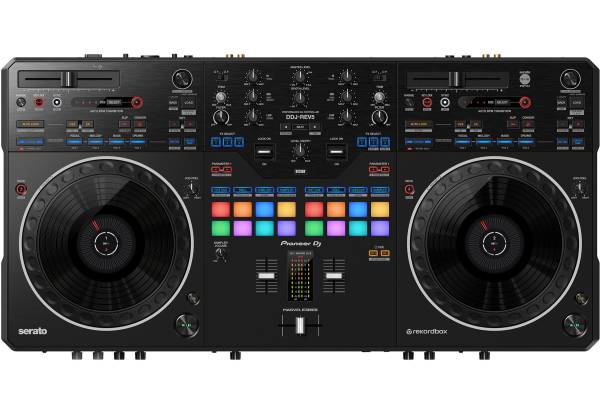The DDJ-Rev5 is an extremely powerful performance DJ controller that provides nearly every function you need for a complex open-format DJ set with Serato DJ Pro - which, by the way, includes the important add-on Pitch'n'Time. If you liked the REV7 but prefer CDJ-like jog wheels, the REV5 is the right choice for you. It offers some new features not found on the REV7, such as Piano Play and Auto Beat Transition. However, it lacks the external mixer functionality, and you may miss having four physical mixer channels. But more on that in our review...
First Impression / Setup
At first glance, the Pioneer DJ DDJ-Rev5 appears slightly less premium than the top-of-the-line REV7. It weighs significantly less (no built-in motors as it has static CDJ-style jog wheels instead of motorized platters), it's a bit slimmer, has rounded corners, and feels more plastic-like. This impression is reinforced by the smaller performance pads and paddles compared to the REV7, as well as the somewhat below-average central displays of the jog wheels.
However, this impression fades away once you get familiar with the numerous features that the DDJ-Rev5 has to offer. It includes high-quality construction of controls, including a Magvel Crossfader. Essentially, the DDJ-Rev5 provides almost all the software control features of the DDJ-REV7 and even more, such as four-deck control and some useful and exciting new features that have not been seen on any Serato DJ controller before. As expected, it fully supports Serato DJ's Stems feature and offers some excellent functionalities.
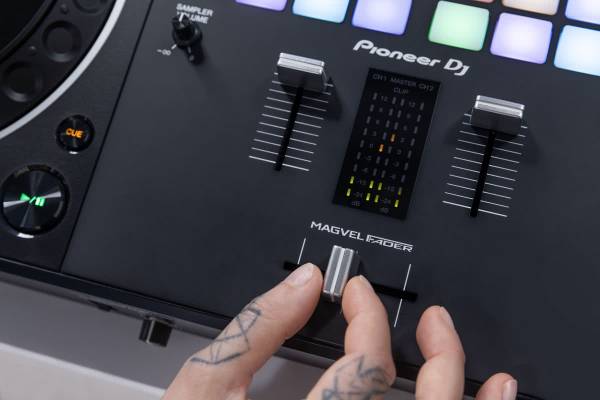
Rev5 Package Contents
- The Rev5 Controller itself
- Power cable
- AC Adapter
- USB-C cable
- Serato DJ Pro Pitch 'n Time DJ voucher
- Quick Start Guide
- Warranty & Safety Information
Here are the technical specifications of the controller at a glance:
| Supported Software | Serato DJ Pro rekordbox |
|---|---|
| Frequency Range | 20 Hz - 20 kHz |
| Signal-to-Noise Ratio (S/N ratio) | 110 dB (USB) |
| 95 dB (LINE) | |
| 89 dB (PORTABLE) | |
| 81 dB (MIC1 & MIC2) | |
| Total Harmonic Distortion | 0.003% dB (USB) |
| Input and Output Terminals | Inputs: AUX (1x RCA) 2x MIC (1x XLR & 1/4" TRS Jack | 1x 1/4" TRS Jack) |
| Outputs: 2x MASTER (1x XLR | 1x RCA) BOOTH (1x 1/4" TRS Jack) 2x PHONES (1x 1/4" Stereo Jack | 1x 3.5 mm Stereo Mini Jack) | |
| USB Ports | 3x USB Type-C (2x for PC/Mac connection | 1x for power supply) |
| Power Supply | AC Adapter (DC 5 V, 3.0 A / DC 9 V, 3.0 A / DC 12 V, 3.0 A / DC 15 V, 3.0 A / DC 20 V, 2.25 A) |
| Power Consumption | 3 A |
| Weight | 6.2 kg |
| Dimensions (Width x Depth x Height) | 736 x 377.2 x 73.4 mm |
CDJ-Style Jog Wheels, Layout for Turntablists
The biggest change compared to the DDJ-REV7, apart from switching to CDJ-style jog wheels (which many prefer over motorized platters), is that it does not offer the option to use it as an external mixer. The REV7 has two phono/line inputs that allow it to be used as an external mixer, but such inputs are not available on the REV5. It only provides an auxiliary input for an additional external source. However, it is well-equipped with inputs and outputs, including two microphone channels, balanced and unbalanced master outputs, TRS booth outputs, and two USB ports for two laptops (USB-C), as well as USB PD power supply (an adapter is included in the package).
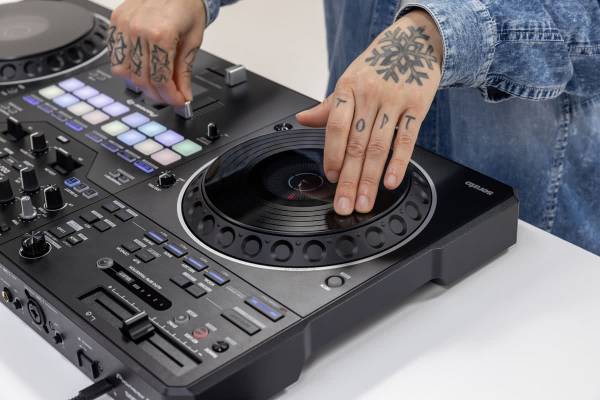
Having CDJ-like jog wheels on a device with pitch controls placed horizontally at the top of each deck, in the classic style of scratch turntables, might feel a bit unusual. It was a design choice that even challenged the traditional understanding of how a DJ setup should look with the REV7, which actually had platters that resembled and felt like real turntables. However, the DDJ-Rev5 is the first DJ device ever to provide this CDJ feeling and arrangement. While it may seem a bit odd at first, it certainly is not a deal-breaker. On the contrary, the layout makes sense as it allows enough space in the center of the device (next to the full-size jog wheels) without making the entire unit too large.
Similarities to the REV7
Just like the REV7, the mixer section of the DDJ-Rev5 is based on the look and feel of the DJM-S series of scratch mixers. The performance pads are placed above the clear two-channel fader/crossfader layout. The FX control paddles are solely used to control software effects. The EQs and gain knobs are arranged following the design of the DJM-S7/9.
Some changes from the DDJ-REV7 include the relocation of the headphone controls to the front edge of the device, the addition of a mechanical jog feel adjuster for each jog wheel (at the expense of the physical vinyl brake adjust knob), and the inclusion of temporary cue buttons.
In Use: A Deeper Look at the Pioneer DJ DDJ-Rev5
The Pioneer DJ DDJ-Rev5 impresses with its intuitive user-friendliness and the wealth of performance features once it's powered on and connected to a laptop. The Pioneer DJ DDJ-Rev5 stands out for its user-friendly interface and intuitive control. The size is optimal, the jog wheels offer an immediately noticeable, excellent feel, and all elements are spaced well enough apart to allow for relaxed and intuitive operation. The lighting is bright yet stylish, and the RGB pads feel great and provide plenty of information in the various pad modes.
The Concept
The concept of the DDJ-Rev5 is to provide deep and innovative software control, with a strong focus on the needs of open-format and performance DJs. It features four additional performance buttons above each deck, which offer more control than usual. Additionally, there are many clever additions, including automatic BPM changes.
Setup and Connectivity
Thanks to the included software, Serato DJ Pro, setting up the DDJ-Rev5 is straightforward. Once the software is installed on the computer, connecting the controller is a simple plug-and-play process. One clear advantage is that the DDJ-Rev5 comes with two USB ports, making it ideal for back-to-back sets or seamless transitions between two DJs.
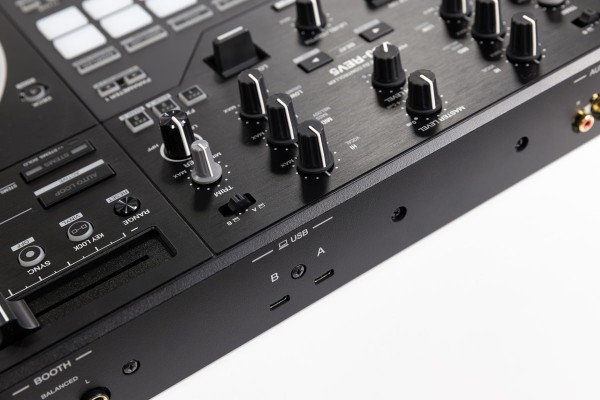
Control and Navigation
With the DDJ-Rev5, navigating through the Serato library is a breeze. Scrolling through tracks, loading decks, and setting cues is intuitive and fast. The central displays of the jog wheels not only show track information but also indicate the current position within the track, which is helpful for cueing and scratching. The jog wheels themselves are precise and responsive, with an adjustable jog feel feature that allows you to customize the resistance to your preference.
Performance Features
The performance pads on the DDJ-Rev5 provide access to a wide range of functions. From hot cues to loop rolls, slicer, and sampler, DJs can enhance their sets with additional elements and effects. Of particular note is the new Piano Play feature, which allows you to control pitch changes of samples using the performance pads, taking the creative use of sounds and effects to a new level. More on this later.
With the FX paddles placed above the jog wheels, you can apply and control Serato's internal effects intuitively, both momentarily and continuously.
Mixer Section
In the center of the DDJ-Rev5 is the mixer section, which at first glance strongly resembles Pioneer's own DJM-S mixers. The high-quality line faders and the Magvel Crossfader provide an excellent mixing experience. They feel smooth and allow for precise transitions, whether you're gently adjusting the faders or engaging in intense scratching.
With three-band EQs and gain controls for each channel, the DDJ-Rev5 offers sufficient control over the tonal color of each track. Additionally, dedicated filter knobs can be used for creative transitions and effects.
Auto Beat Transition
Auto Beat Transition is an innovative feature that can be especially useful for open-format DJs, as it allows for automated BPM changes between two tracks.
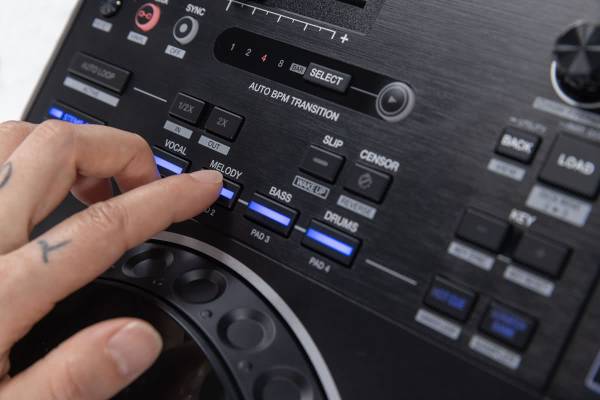
The principle is simple yet powerful: You set a length that can range from one beat to eight beats, during which the BPM of the currently playing track will automatically change. Then, you press a dedicated "Transition Play" button, and the BPM of the playing deck changes over the set number of beats to the original BPM of the track on the other deck (if synchronization is active) or to the BPM set on the other deck (if synchronization is not active).
This allows you to easily and quickly create BPM transitions that remain precise and smooth. A special advantage of this feature is that during these transitions, the track on the other deck is temporarily also linked to the BPM of the outgoing deck. This means that you can start the other deck at any time, and the BPMs will be kept in sync, which would otherwise be challenging to achieve, especially if you're not using synchronization.
Pre-programming Transitions
But the Auto Beat Transition goes a step further and offers you the ability to pre-program the transitions. When setting the number of beats for the automatic transition, you can use just three additional taps to specify which stems should play during the transition, set an auto-loop for the transition, and determine whether the key lock should be active during the transition or not.
Once you press the Transition Play button to initiate the BPM change, your selected stems, loop length, and key lock will also be activated or deactivated. This allows you to pre-set these settings a little in advance, enabling you to create all sorts of combinations in your Auto Beat Transitions.
It's a powerful feature that many open-format DJs will love.
Piano Play
Piano Play is a highly innovative feature that emerged from the physical arrangement of the performance pads on your controller. A creative mind at Pioneer DJ noticed that with this layout, all the performance pads are placed right next to each other, with eight in the bottom row. The question arose: "What if we consider the eight performance pads in the bottom row as the eight keys of an octave on a piano, and five of the eight pads above as the 'black' keys?" And so, Piano Play was born, as an evolution of the Pitch Play idea, where you set a cue point and then "play" that cue point "über" the pads at different pitches.
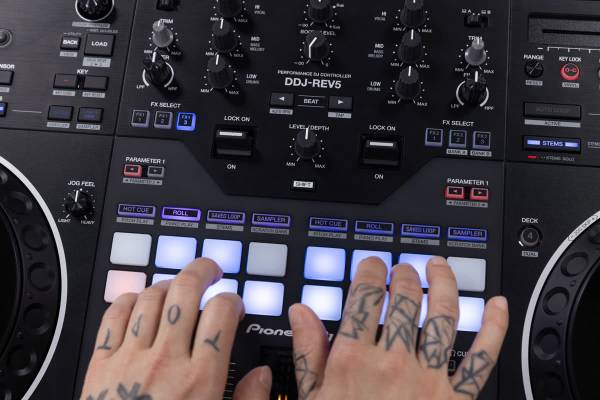
Implementing this feature across all 16 pads makes it much more intuitive to play new riffs using existing melodic elements like a synth tone or a vocal stab. To use this mode, you simply activate the pad mode, select a hot cue, and then start playing - the "black" keys light up blue, and the white keys are white. You can use the parameter buttons to cycle the pitches up and down, giving you a wider range of notes to work with. You can even choose major and minor pentatonic scales, which will show you notes that could work well in a riff. This means you don't have to be musically inclined to play something that sounds good.
One interesting feature that would have been great to have is the ability to play chords, but strictly speaking, it's only possible to play one note at a time - still, it's a fantastic improvement over Pitch Play.
With Piano Play, you gain a new level of control and creativity over your music that you might not have had before. You can reshape and remix your tracks in real-time with an intuitive and musical interface that feels great and is fun to use. Whether you're playing a melody on the pads, altering a hook line, or just experimenting, Piano Play opens up a new world of performance possibilities.
Additional Performance Button Sets
Above each jog wheel, you'll find a set of additional performance buttons, just like the REV7. However, the scratch function from the REV7 is now replaced with Stems. When you press the "Stems" button, you can turn all four stems in Serato (vocals, melody, bass, drums) on and off. Double-tapping the Stems button allows you to instantly isolate any of these elements.
In addition to these functions, there are two more selection buttons that let you control the first four pads of your hot cues, saved loops, scratch bank, and sampler from this area. The aim of this setup is to provide you with additional control over the performance pad functions, so you don't have to switch modes on the pads as often. These additional controls are useful, and DJs are likely to find a function they prefer for their style of play - and that might not necessarily be Stems, as Stems are cool on the "real" performance pads with their Pad FX on the lower four pads.
Software Effects
Considering that this controller doesn't have external decks, the effect controls are designed for the integrated effects in Serato. You have control over six independent effects and the ability to switch between two effect banks directly from the device. There's a wet/dry control and two up/down beat buttons for adjusting the cycle length. Of course, there are also two paddles to temporarily or permanently enable/disable the effects.
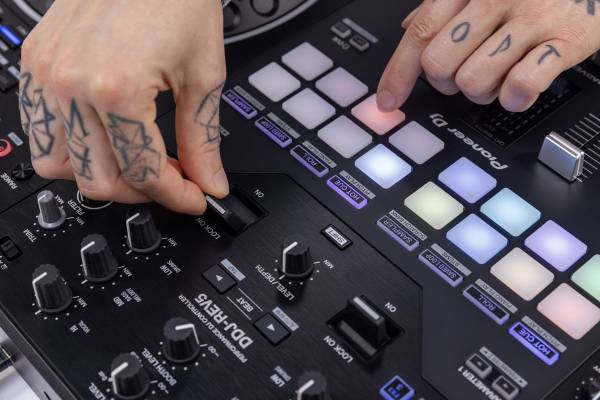
This setup strikes a good balance between control and flexibility. You set up the effects as you like, and then everything is right at your fingertips. This configuration is definitely advantageous when you have multiple FX set up in Serato. You can activate more than one effect simultaneously by pressing the button of one effect and - while holding it down - pressing another button.
The way the additional performance buttons and software effects are integrated into the REV5 controller shows how much Pioneer DJ is dedicated to giving DJs maximum control over their music. These are features that can help elevate your DJ sets to the next level by providing you with new ways to control and shape your music. Whether you're controlling individual stems of your tracks or experimenting with the built-in software effects, these features can help bring your music to life in new and exciting ways.
Dual Deck Mode
Since the REV5 can control four decks (in the standard way, with "layer" buttons), it also offers a "Dual Deck" mode. Here, you can link the two left and right decks together and essentially treat them as one deck, allowing you to control both simultaneously.
While this feature may seem a bit complex at first glance, it gives you an additional level of control over your mixes. For example, if you have a sample playing on one deck and a beat running on another, with Dual Deck mode, you can synchronize both decks and control them as if they were a single deck. This can be particularly useful when creating more complex mixes and transitions.
It's worth noting that due to the fact that this unit is only a two-channel mixer, this feature can be a bit tricky to use. This means that if you want to control both decks as one, you'll have to use the same channel for both decks. This may be a little confusing at first, but with a little practice, you'll quickly get the hang of it.
Additional Features
In addition to the features mentioned earlier, the REV5 offers a range of other functions that make it a powerful controller for DJ performances.
For example, the controller includes pitch range control, a pitch reset function, a slip mode, a key lock function, and a shift and sync function (with the sync function finally taking "fuzzy" key mixing into account - a big plus for Serato!). There's also a censor/reverse function and the ability to create and control loops both automatically and manually.
On the hardware side, the REV5 has two USB ports (now USB-C), two microphones with individual level controls (but shared EQ), an adjustment option for the jog wheel feel, and physical crossfader curve controls.
Another notable feature is the 12 pad modes, including a split pad mode where you can distribute the first four pads for two modes across the eight pads. Accessing the "third" set of modes is done by double-tapping a pad select button, and two of them are user-definable.
All of these additional features contribute to making the REV5 a versatile and powerful controller suitable for a variety of DJ styles. Whether you're an open-format DJ requiring fast BPM transitions or a performer experimenting with samples and effects, the REV5 has the functions and flexibility to support you in your creative process.
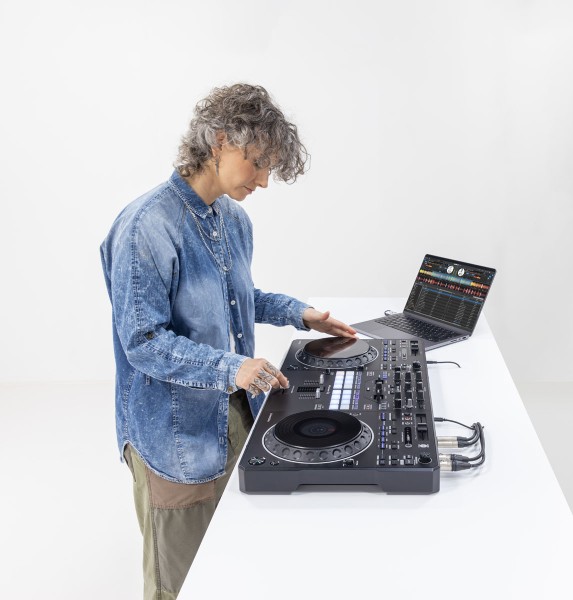
Our Verdict
After a thorough evaluation and testing of the Pioneer DJ DDJ-Rev5 in action, we can draw a nuanced conclusion that takes into account the strengths and weaknesses of the device.
On the strength side, the DDJ-Rev5 stands out for its intuitive user-friendliness and the wealth of features it offers. The seamless integration with Serato DJ Pro allows for easy operation, while the plug-and-play setup makes the device ideal for quick deployment. The two USB ports are a significant advantage, facilitating collaboration between multiple DJs, especially in live event environments.
In terms of control and navigation, the DDJ-Rev5 shines with its precise and responsive jog wheels. The customizable jog feel setting is an excellent addition that allows users to adjust the sensitivity of the jog wheels to their preferences. The central displays on the jog wheels are helpful and significantly aid navigation.
The impressive performance features of the DDJ-Rev5, particularly the versatile performance pads and the innovative Piano Play function, enable DJs to shape their sets in creative ways. The FX control paddles, which allow for intuitive application and control of effects, are also a major plus.
The mixer section of the DDJ-Rev5 is robust and reminiscent of the quality found in Pioneer's DJM-S mixer series. With its high-quality faders and dedicated filter knobs, the DDJ-Rev5 enables precise and creative control of tracks.
However, there are also some areas where the DDJ-Rev5 could be improved. Some users might miss the absence of certain premium features found in the DDJ-Rev7, such as expanded connectivity options and additional control possibilities. However, these aspects are less critical for DJs seeking a solid, versatile, yet affordable controller.
In summary, the Pioneer DJ DDJ-Rev5 is an outstanding DJ controller despite some minor limitations. It offers an impressive array of features and intuitive operation that appeals to DJs of all experience levels. The DDJ-Rev5 is thus a strong choice for anyone in search of a robust and versatile controller that still allows room for creative expression.
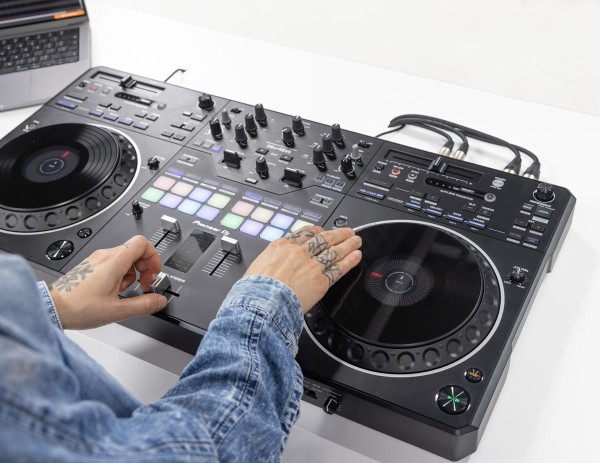
| Pro | Contra |
|---|---|
| Intuitive user-friendliness | Missing some premium features compared to DDJ-Rev7 |
| Seamless integration with Serato DJ Pro | Less premium material feel, more plasticky |
| Plug-and-play setup | 4 channels only via deck select - Only 2 "real" channels |
| Two USB ports for easy DJ switching | No motorized jog wheels like in the Rev7 |
| Precise, responsive jog wheels with customizable jog feel setting | "Only" a Magvel Crossfader (REV7: Magvel PRO) |
| Central displays on the jog wheels for easy navigation | |
| Versatile performance pads | |
| Innovative Piano Play function | |
| Intuitive FX control paddles | |
| High-quality mixer section reminiscent of the DJM-S mixer series | |
| Affordable compared to similarly specified models |

